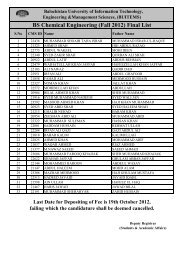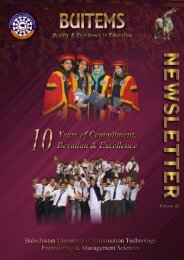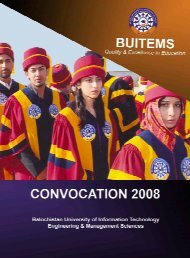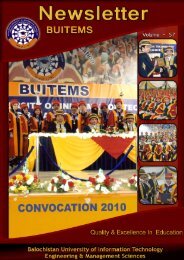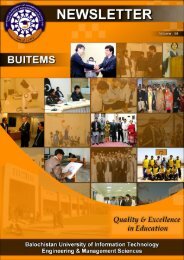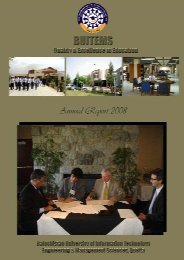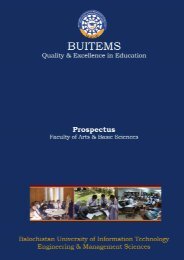BUITEMS
Research Journal - buitems
Research Journal - buitems
- No tags were found...
Create successful ePaper yourself
Turn your PDF publications into a flip-book with our unique Google optimized e-Paper software.
<strong>BUITEMS</strong><br />
Quality & Excellence in Education<br />
Exploring the Impact of Trade Liberalization on Economic Growth for Pakistan<br />
industrialization. This protectionist trade<br />
policy continued for almost three decades,<br />
from the 1950s to 70s. Although the<br />
protectionist regime proved to be relatively<br />
effective in protecting fledging domestic<br />
industries, the lack of foreign competition<br />
permitted the Pakistani investors to invest in<br />
safe but less efficient industrial sectors such<br />
as, automobile manufacturing, electronics,<br />
and electrical appliances industries.<br />
Consequently, many industries in Pakistan<br />
became gradually inefficient and vulnerable<br />
to the import substitution regime. It became<br />
difficult for local products to compete<br />
imported products on the basis of price or<br />
quality. The ultimate outcome is that the<br />
industries continued to enjoy the government<br />
protection are now finding it difficult to survive<br />
and compete with foreign products even in<br />
local market (Rodriguez and Rodrik, 2001).<br />
Protection from foreign competition is not a<br />
new phenomenon in Pakistan. Since 1952,<br />
a multifarious system of trade policy was<br />
maintained in Pakistan and different tariff<br />
rates were adopted for different commodities.<br />
The major reason was not only to protect the<br />
newly established domestic industries but<br />
also to generate revenue. Many types of<br />
trade barriers like quota, import bans, high<br />
tariff rates, licensing requirements, and<br />
others were introduced to protect domestic<br />
industries. Unfortunately, owing to smuggling<br />
and corruption these objectives were not<br />
achieved. Until 1981, about 41 percent of<br />
industrial value added products were<br />
protected by the import bans and another 22<br />
percent by various other forms of trade<br />
restrictions (Siddiqui and Kemal 2002).<br />
Meanwhile, there has been considerable<br />
progress in trade liberalization in most<br />
developing countries, turning from import<br />
substitution strategy to export-oriented<br />
approach in the 1970s. Trade liberalization<br />
policy has actively contributed to enhance<br />
the economic performance of many<br />
developing economies. Hence, the<br />
Government of Pakistan also introduced few<br />
additional trade liberalization measures to<br />
encourage exports during that period. The<br />
devaluation of the Pakistani Rupee by 57%<br />
in 1972 and elimination of the export bonus<br />
scheme were few important measures to<br />
stimulate export. Additionally, the<br />
discontinuation of restrictive licensing<br />
scheme was another important policy step<br />
towards trade liberalization (Onafowora et al.,<br />
1998). In early 1980s, trade policy reforms<br />
were initiated in Pakistan with a view to<br />
create a competitive and efficient industry<br />
through easing the import of raw material,<br />
intermediate goods and capital equipment.<br />
In order to achieve the efficiency and<br />
competitiveness, the domestic market was<br />
liberalized and trade barriers were removed<br />
gradually. Instead of quantitative restrictions<br />
tariff is being used to protect domestic<br />
industries and tariff structure has also been<br />
rationalized. The customs duty itself was<br />
lowered substantially from 80 per cent in<br />
1996 to 30 per cent in 2001 and to 25 per<br />
cent in 2002.The average applied tariff rate<br />
fell from 42.7 per cent in 1996-97 to 20.4 per<br />
cent in 2001-02. During 1983-84 to 1993-94,<br />
724 items were removed from the negative<br />
list. Overall, the number of goods on the<br />
negative list was reduced from 142 to 16, 32<br />
to 7 and 221 to 107, respectively. In 2002,<br />
only 57 items constituted the negative list of<br />
imports and 192 items remained on the<br />
restricted list due to health and safety<br />
concerns. Only an insignificant portion of total<br />
imports is subject to quantitative restrictions.<br />
All these changes resulted in a decline in<br />
protection rates.<br />
Tariff structure was rationalized further in the<br />
1988-91 by the Government of Pakistan<br />
(GOP) after reducing the quantitative<br />
restrictions by the reduction in tariff rates and<br />
their dispersion. Tariffs were reduced on<br />
1134 items and increased on 462 items. The<br />
maximum tariff was reduced from 225<br />
percent to 100 percent. In June 1995, the<br />
tariff was further reduced to 65 percent.<br />
During the same periods the number of tariff<br />
slabs was reduced to 10. Except for<br />
automobiles and alcoholic drinks, the<br />
maximum tariff rate was reduced to 25<br />
percent and the number of tariff slabs has<br />
been reduced to four (Rodrick et al, 2004).<br />
If we examine the structure of trade during<br />
the decades of eighties and nineties, we can<br />
see that the share of imported capital goods<br />
in total imports has increased from 28 percent<br />
in 1981 to 37 percent in 1985-86. However<br />
due to slow down in the industrial sector the<br />
import of capital good declined to 25 percent<br />
74



